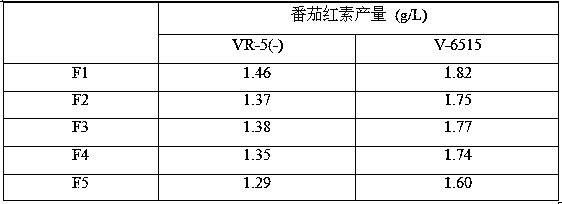Lycopene high-yielding strain and application thereof
A technology of lycopene and high-yielding strains, applied in fungi, microorganisms, biochemical equipment and methods, etc., can solve the problems of cumbersome operation and increase the risk of bacterial infection, and achieve simple operation, great social significance and economic value, cost reduction effect
- Summary
- Abstract
- Description
- Claims
- Application Information
AI Technical Summary
Problems solved by technology
Method used
Image
Examples
Embodiment 1
[0034] Example 1: This example illustrates the method of mutagenizing the starting strain of B. trispora.
[0035] Taking the B. trispora VR-5(-) preserved in the laboratory as the starting strain, the mutagenesis is carried out, and the specific steps are as follows:
[0036] (a) Preparation of monospore suspension: the spores of the starting strain of B. trispora were prepared into a spore suspension, and there was no overlapping of cells under microscope inspection.
[0037] (b), in order to obtain the lycopene high-yield bacterial strain, after comparing multiple mutagenesis methods, select nitrosoguanidine (MNNG) to mutagenize the three spora boulardii ( blakeslea trispora ) strain method. from B. trispora in liquid medium ( blakeslea trispora ) culture to obtain the cell suspension to be mutagenized. At 20°C and 100rpm, the 10 8 Cells / ml in 0.1M sodium citrate buffer solution of 250ug / ml MNNG solution, pH 5.0 medium temperature bath for 60-120min, then inoculate the ...
Embodiment 2
[0043] Example 2: This example illustrates the passage stability of mutant strains.
[0044] Bacteria trispora boulardii of the present invention blakeslea trispora The main morphological and biological characteristics of V-6515 are as follows:
[0045] The colony is light yellow on the PDA medium and grows under aerobic conditions. The colony is large and round, with thick mycelium, neat edges, and uniform texture. The suitable growth temperature is 27.5-28.5°C. The suitable pH for growth is 7.0-7.2.
[0046] Detection of Mutant B. trispora in Fermentation Medium Using Cassava Flour as Carbon Source blakeslea trispora The subculture stability of V-6515, the strain subculture fermentation test results are shown in Table 1:
[0047] Table 1 High-yielding mutant strains of B. trispora blakeslea trispora V-6515 stability test
[0048]
[0049] It can be seen from the experimental results that after 5 passages, the mutant strain B. trispora blakeslea trispora The lyco...
Embodiment 3
[0050] Embodiment 3: This embodiment illustrates high-yield bacterial strain B. trispora B. trispora blakeslea trispora V-6515 fermentation process for producing lycopene.
[0051] The medium formula used in this embodiment:
[0052] The solid medium is: cassava flour 3.0%, malt extract powder 1.0%, agar powder 1.5%, pH 7.0-7.2, and distilled water.
[0053] The seed medium is: cassava flour 4.0%, soybean cake flour 2.0%, potassium dihydrogen phosphate 0.2%, magnesium sulfate 0.05%, pH 7.0-7.2, tap water configuration.
[0054] The fermentation medium is: cassava flour 2.0%, soybean cake flour 4.0%, potassium dihydrogen phosphate 0.2%, magnesium sulfate 0.05%, corn oil 3.0%, vitamin B 1 0.0002%, pH 7.0~7.2, tap water configuration.
[0055] B. trispora blakeslea trispora V-6515 was inoculated on a solid medium, the culture temperature was 28°C, and the culture time was 48 hours; the solid-cultured B. trispora blakeslea trispora The V-6515 culture was inoculated into t...
PUM
 Login to View More
Login to View More Abstract
Description
Claims
Application Information
 Login to View More
Login to View More - R&D
- Intellectual Property
- Life Sciences
- Materials
- Tech Scout
- Unparalleled Data Quality
- Higher Quality Content
- 60% Fewer Hallucinations
Browse by: Latest US Patents, China's latest patents, Technical Efficacy Thesaurus, Application Domain, Technology Topic, Popular Technical Reports.
© 2025 PatSnap. All rights reserved.Legal|Privacy policy|Modern Slavery Act Transparency Statement|Sitemap|About US| Contact US: help@patsnap.com


